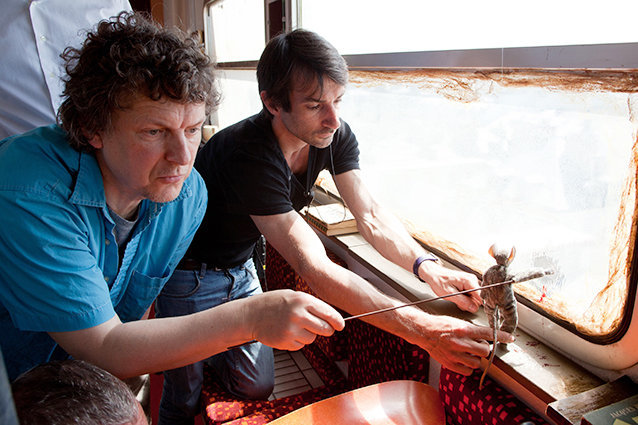
The word “auteur” gets thrown around a ton in Hollywood, but few filmmakers truly earn the title like Michel Gondry. Over his career, the French filmmaker has fine-tuned a unique visual style that separates him from his peers and really makes his work distinct. Gondry, at his best, thrives on the absurd and creates abstract, dream-like imagery that doesn’t distract from the characters who populate his stories. He lets thing get weird, but never for the sake of just being weird. In celebration of his latest film, Mood Indigo, we’re taking a look at the Gondryest elements in our favorite Michel Gondry films.
Eternal Sunshine of the Spotless Mind
In Eternal Sunshine, a grief-striken Joel Barrish (Jim Carrey) tries to erase all memories of his long time girlfriend, but he soon learns that it really is better to have loved and lost than to not have loved at all. The film’s Gondryest moments surface when Joel is hurtling backwards through all of his memories with his girlfriend Clementine (Kate Winslet). The director uses his visual panache to depict how the mind tends to distort what we think we remember. Joel’s memories start fusing together as he travels through his past, and Gondry plays with size and perspective in some curious and fun ways — most notably, shrinking Carrey down to the size of a toddler for a childhood memory scene.
The Science of Sleep
Gondry is the perfect filmmaker to tackle the surreal world of the subconscious. He dives into the dreams of halfway delusional artist Stéphane (Gael García Bernal), bastardizing the visual scope and the passage of time. One particularly wild scene early on in the film tosses Stéphane into a dream about his office workers that involves sporadic bouts of sexual intercourse, various pieces of papier-mâché set dressing, and a gigantic pair of human hands.
Be Kind Rewind
Sure, we could all make low-rent versions of Ghostbusters and Rush Hour in our backyards, but they wouldn’t turn out one tenth as funny or visually appealing as the “remakes” peppered throughout Be Kind Rewind. Even though most of the sets, costumes, and effects look like they were made with construction paper, cardboard, and junkyard junk, Gondry’s knack for great aesthetics shines through.
The Green Hornet
The Green Hornet is definitely the director’s least Gondry film to date. There’s hardly much about the Seth Rogen action-adventure that points to the director’s usual dreamlike visual style, but the one small Gondryism in a mostly dull film is the liberal use of Kato-vision. The Hornet’s masked assistant Kato (Jay Chou) dispatches enemies by way of a crafty visual effect where his mind highlights the dangers in the environment like a Terminator, and slows his combatants down to a crawl so he can dole out maximum punishment. It’s a trippy and original way to do slow-mo – an effect we were growing pretty tired of – and proof that the filmmaker wasn’t completely asleep while making the 2011 film.
The We and the I
Although we usually associate Gondry’s style with the visual, here we see his flare for the aural. Gondry sticks to accepted “reality” in The We and the I, a film about the buzzing subcultures aboard a bus ride home from high school in The Bronx. Even though The We and the I lacks literal trips into the human mind, home-made videos, or superpowers, Gondry’s attention to rhythm still allows for a few steps away from naturalism. The kids move, talk, and breathe in a fast-paced harmony, making the film (and lengthy busride) speed by with terrific energy.
Is the Man Who Is Tall Happy?
An intellectual conversation with one of the modern age’s greatest thinkers (Noam Chomsky), delivered in the form of hand-drawn illustrations that resemble urban sidewalk chalk scribbles? How much Gondryer can you get than this inviting documentary? Well, maybe Mood Indigo.


